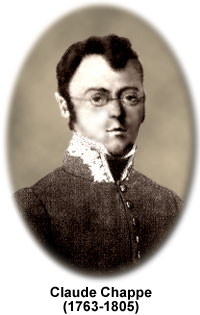Claude Chappe
(1763-1805)

Claude Chappe was an engineer and cleric who invented a device known as the semaphore visual telegraph, an optical signaling system especially important during the French Revolution. Born on December 25, 1763 in Brûlon, France, Chappe was one of five brothers, and the grandson of a French baron. His early education was undertaken in Rouen, and Chappe later entered the seminary at la Flèche. After completing his studies, Chappe was appointed commendatory abbot, a sinecure that provided him with enough money to create a small laboratory.
Perhaps influenced by his uncle, abbot Jean Chappe d'Hauteroche, who was a member of the Academy of Sciences, Chappe carried out various experiments in the physical sciences. He was particularly interested in static electricity, and when the French Revolution commenced, he began to consider how to quickly send messages over long distances. As he studied the work of earlier scientists and experimented with various types of transmitters, his system slowly developed.
Since the use of static electricity proved impractical at the time, Chappe invented an optical transmission system. By constructing towers that were equipped with telescopes and placed at periodic distances from each other, Chappe believed a signal could be quickly transmitted over vast expanses of land. However, the signal would have to be large enough that too many towers, which would be expensive and time consuming to construct, would not be need to be built. The signal would also have to be capable of portraying a great number of potential messages in order for it to be very useful. To fulfill these requirements, Chappe developed the semaphore, a device with large movable arms that could be arranged in different positions, which could indicate various words, letters, or numbers.
Due to the magnitude of such a project, Chappe needed the permission of the government in order to carry out trials. Once it was gained in 1791, he carried out some early experiments in Paris, but with little success. However, his brother Ignatius was elected to the Legislative Assembly that same year and facilitated Chappe's presentation of the project to the government body in 1792. Although other minor setbacks ensued, by the summer of 1793 war was raging to such an extent that the French government could not deny the benefit of such a system. They proposed, however, that the management of the new form of communication should be assumed by the state.
The first line of fifteen towers was completed less than a year later and strategically ran between Paris and Lille, which were separated by about 120 miles. In August of 1794, Chappe's semaphore visual telegraph conveyed in less than an hour the news that the Republican army had recaptured Condé-sur-l'Escaut from the Austrians, a feat that would have taken approximately twenty-four hours if transported by courier on horseback. The system was considered a success and another line was soon installed between Paris and Landau, others following in later years. The system was widely copied throughout Europe and although Chappe was titled engineer of the telegraph, some disputed the claim. The controversy contributed to a sense of despondency building in Chappe, and on January 23, 1805 he committed suicide by throwing himself down a well.
